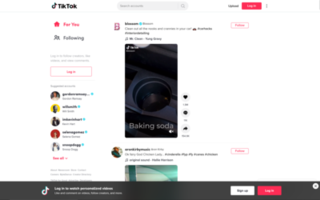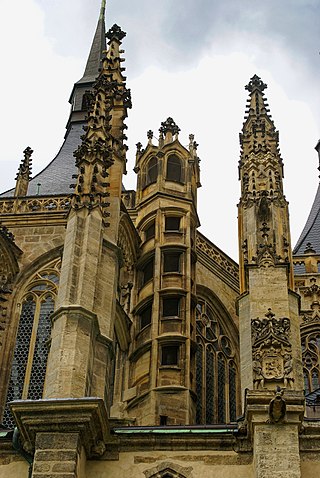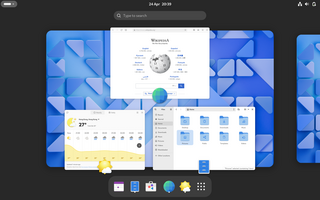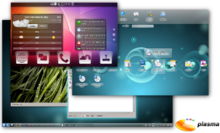
Frutiger is a series of typefaces named after its Swiss designer, Adrian Frutiger. Frutiger is a humanist sans-serif typeface, intended to be clear and highly legible at a distance or at small text sizes. A popular design worldwide, type designer Steve Matteson described its structure as "the best choice for legibility in pretty much any situation" at small text sizes, while Erik Spiekermann named it as "the best general typeface ever".

Univers is a sans-serif typeface family designed by Adrian Frutiger and released by his employer Deberny & Peignot in 1957. Classified as a neo-grotesque sans-serif, one based on the model of nineteenth-century German typefaces such as Akzidenz-Grotesk, it was notable for its availability from the moment of its launch in a comprehensive range of weights and widths. The original marketing for Univers deliberately referenced the periodic table to emphasise its scope.

Adrian Johann Frutiger was a Swiss typeface designer who influenced the direction of type design in the second half of the 20th century. His career spanned the hot metal, phototypesetting and digital typesetting eras. Until his death, he lived in Bremgarten bei Bern.

Aqua is the graphical user interface, design language and visual theme of Apple's macOS and iOS operating systems. It was originally based on the theme of water, with droplet-like components and a liberal use of reflection effects and translucency. Its goal is to "incorporate color, depth, translucence, and complex textures into a visually appealing interface" in macOS applications. At its introduction, Steve Jobs noted that "... it's liquid, one of the design goals was when you saw it you wanted to lick it".

A skeuomorph is a derivative object that retains ornamental design cues (attributes) from structures that were necessary in the original. Skeuomorphs are typically used to make something new feel familiar in an effort to speed understanding and acclimation. They employ elements that, while essential to the original object, serve no pragmatic purpose in the new system. Examples include pottery embellished with imitation rivets reminiscent of similar pots made of metal and a software calendar that imitates the appearance of binding on a paper desk calendar.

Windows Aero is the design language introduced in the Microsoft Windows Vista operating system. The changes introduced by Windows Aero encompassed many elements of the Windows interface, with the introduction of a new visual style with an emphasis on animation, glass, and translucency; interface guidelines for phrasing and tone of instructions and other text in applications were available. New cursors and sounds based on Windows Aero design principles were also introduced.
Applied aesthetics is the application of the branch of philosophy of aesthetics to cultural constructs. In a variety of fields, artifacts are created that have both practical functionality and aesthetic affectation. In some cases, aesthetics is primary, and in others, functionality is primary. At best, the two needs are synergistic, in which "beauty" makes an artifact work better, or in which more functional artifacts are appreciated as aesthetically pleasing. This achievement of form and function, of art and science, of beauty and usefulness, is the primary goal of design, in all of its domains.
The aesthetic–usability effect describes a paradox that people perceive more aesthetic designs as much more intuitive than those considered to be less aesthetically pleasing. The effect has been observed in several experiments and has significant implications regarding the acceptance, use, and performance of a design. Usability and aesthetics are the two most important factors in assessing the overall user experience for an application. Usability and aesthetics are judged by a user's reuse expectations, and then their post-use, or experienced, final judgement. A user's cognitive style can influence how they interact with and perceive an application, which in turn can influence their judgment of the application.

TikTok, whose mainland Chinese and Hong Kong counterpart is Douyin, is a short-form video hosting service owned by Chinese internet company ByteDance. It hosts user-submitted videos, which can range in duration from three seconds to 60 minutes. It can be accessed with a smart phone app.

Dark academia is an internet aesthetic and subculture concerned with higher education, the arts, and literature, or an idealised version thereof. The aesthetic centres on traditional educational clothing, interior design, activities such as writing and poetry, ancient art, and classic literature, as well as classical Greek and Collegiate Gothic architecture. The trend emerged on social media site Tumblr in 2015, before being popularised by adolescents and young adults in the late 2010s and early 2020s, particularly during the COVID-19 pandemic.
Hyperpop is a loosely defined electronic music movement and microgenre that predominantly originated in the United Kingdom during the early 2010s. It is characterised by an exaggerated or maximalist take on popular music, and typically integrates pop and avant-garde sensibilities while drawing on elements commonly found in electronic, hip hop, and dance music.

The fashions of the 2020s represent a departure from 2010s fashion and feature a nostalgia for older aesthetics. They have been largely inspired by styles of the late 1990s to mid-2000s, and 1980s. Early in the decade, several publications noted the shortened trend and nostalgia cycle in 2020s fashion. Fashion was also shaped by the COVID-19 pandemic, which had a major impact on the fashion industry, and led to shifting retail and consumer trends.
The Consumer Aesthetics Research Institute (CARI) is an online community which is "dedicated to developing a visual lexicon of consumer ephemera from the 1970s until now".

Indie sleaze was a fashion style popular in the United States and United Kingdom from approximately 2006 to 2012. Characterised by an affordable, messy and lethargic take on vintage fashion styles, especially the 1970s, the style was particularly popular amongst the hipster subculture and indie rock bands.

Adwaita is the design language of the GNOME desktop environment. As an implementation, it exists as the default theme and icon set of the GNOME Shell and Phosh, and as widgets for applications targeting usage in GNOME. Adwaita first appeared in 2011 with the release of GNOME 3.0 as a replacement for the design principles used in Clearlooks, and with incremental modernization and refinements, continues with current version releases.

Hyram Yarbro is an American skincare influencer known for his videos on YouTube and TikTok. His videos consist primarily of product reviews, skin care advice, and reactions to celebrity skincare routine videos. In 2021, he launched his skincare product line, Selfless by Hyram, with Sephora.
An Internet aesthetic, also simply referred to as an aesthetic or microaesthetic, is a visual art style, sometimes accompanied by a fashion style, subculture, or music genre, that usually originates from the Internet or is popularized on it. Throughout the 2010s and 2020s, online aesthetics gained increasing popularity, specifically on social media platforms such as Tumblr, Pinterest, Instagram, and TikTok, and often were used by people to express their individuality and creativity. They can also be used to create a sense of community and belonging among people who share the same interests. The term aesthetic has been described as being "totally divorced from its academic origins", and is commonly used as an adjective.

Aliyah Bah, known professionally as Aliyah's Interlude, is an American influencer and rapper. After starting her TikTok account in 2020, she became popular on the platform in 2022 for her fashion aesthetic, which became known as AliyahCore online. Her debut single, "It Girl", was released in 2023 and went viral on TikTok.

Y2K is an Internet aesthetic based around products, styles, and fashion of the late 1990s and early 2000s. The name Y2K is derived from an abbreviation coined by programmer David Eddy for the year 2000 and its potential computer errors. The Y2K aesthetic can include synthetic or metallic materials, inflatable furniture, computer interfaces of the dotcom era, and parts of the McBling aesthetic.















